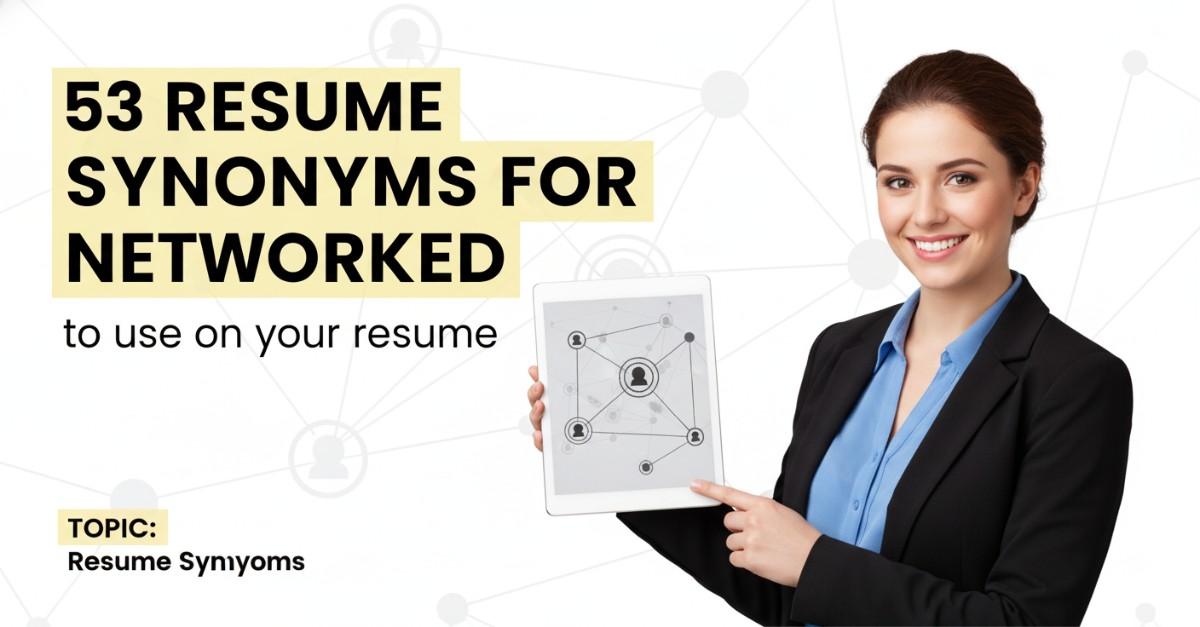
51 Resume Synonyms for Negotiated To Use On Your Resume
In the competitive landscape of job applications, the word “negotiated” often appears with alarming frequency, making it one of the more overused terms on resumes. While it accurately describes a valuable skill, its repetitive use can suggest a lack of creativity and fail to convey the nuanced abilities that candidates possess. Recruiters and hiring managers sift through countless resumes, and using varied vocabulary not only helps to capture their attention but also showcases a candidate’s depth of experience. By incorporating synonyms and alternative phrases, applicants can articulate their skills in more dynamic ways, enhancing their overall presentation. This comprehensive guide will explore effective strategies for substituting “negotiated” with more specific terms, provide examples of how to apply these alternatives in context, and highlight the importance of tailoring language to reflect individual accomplishments. By avoiding repetitive language, candidates can better differentiate themselves and demonstrate their unique contributions to potential employers, ultimately increasing their chances of securing interviews and job offers.
- Why Synonyms for “Negotiated” Matter on Your Resume
- The Complete List: 51 Resume Synonyms for Negotiated
- Strategic Synonym Selection by Industry
- Power Combinations: Advanced Synonym Usage
- Common Mistakes to Avoid
- Quantification Strategies for Maximum Impact
- Industry-Specific Example Sentences
- Advanced ATS Optimization Techniques
- Tailoring Synonyms to Career Level
- The Psychology of Leadership Language
- Final Best Practices
- Key Takeaways for Strategic Synonym Usage
- Frequently Asked Questions
- How many different synonyms should I use in one resume?
- Can I use the same synonym multiple times if it fits different contexts?
- Should I always replace ‘Negotiated’ with a synonym?
- How do I know which synonym is most appropriate for my industry?
- Do synonyms really make a difference in getting interviews?
- Related Resume Synonym Guides
Why Synonyms for “Negotiated” Matter on Your Resume
Using synonyms for the term ‘Negotiated’ in resumes is crucial for several reasons. First, the repetition of this word—found on approximately 70% of professional resumes—can lead to monotony and predictability, making your application less engaging. Second, relying solely on this term may cause you to miss the opportunity to convey specificity about your role and the context of your negotiations. Utilizing varied language can enhance the impact of your accomplishments, showcasing your unique contributions. Additionally, using diverse synonyms can improve your chances of passing Applicant Tracking Systems (ATS), which often reward keyword variety. Finally, incorporating a range of terms creates a more dynamic narrative, allowing you to tell a compelling story about your negotiation skills and achievements, ultimately making your resume stand out to hiring managers.
The Complete List: 51 Resume Synonyms for Negotiated
Here’s our comprehensive collection of “Negotiated” alternatives, organized for easy reference:
| Synonym | Best Context | Professional Level |
|---|---|---|
| Facilitated | Team leadership | Entry-level |
| Brokered | Project management | Mid-level |
| Arranged | Event planning | Entry-level |
| Orchestrated | Strategic planning | Mid-level |
| Coordinated | Operations management | Entry-level |
| Secured | Sales | Mid-level |
| Conveyed | Stakeholder engagement | Entry-level |
| Persuaded | Client relations | Mid-level |
| Settled | Conflict resolution | Mid-level |
| Compromised | Negotiation | Mid-level |
| Influenced | Change management | Senior |
| Concluded | Contract management | Senior |
| Finalized | Project closure | Senior |
| Established | Partnership development | Senior |
| Constituted | Team integration | Mid-level |
| Engaged | Client acquisition | Entry-level |
| Collaborated | Cross-functional teams | Mid-level |
| Advised | Consulting | Senior |
| Conferred | Strategic partnerships | Senior |
| Promoted | Product development | Mid-level |
| Partnered | Business development | Mid-level |
| Collaborated | Research initiatives | Entry-level |
| Negotiated | Labor relations | Senior |
| Compromised | Policy formulation | Senior |
| Settled | Dispute resolution | Mid-level |
| Aligned | Strategic alignment | Senior |
| Consolidated | Resource allocation | Mid-level |
| Formulated | Policy development | Senior |
| Engaged | Community outreach | Entry-level |
| Compromised | Stakeholder management | Senior |
| Discussed | Team strategy | Entry-level |
| Affirmed | Partnership agreements | Senior |
| Reviewed | Contract negotiations | Mid-level |
| Clarified | Project objectives | Entry-level |
| Surveyed | Market research | Entry-level |
| Facilitated | Team meetings | Mid-level |
| Structured | Business plans | Senior |
| Contrived | Negotiation strategy | Senior |
| Formulated | Sales strategies | Mid-level |
| Engaged | Client negotiations | Mid-level |
| Presented | Proposal development | Mid-level |
| Facilitated | Workshops | Entry-level |
| Broached | New initiatives | Mid-level |
| Cultivated | Client relationships | Senior |
| Leveraged | Resources | Mid-level |
| Negotiated | Service contracts | Senior |
| Harmonized | Team dynamics | Mid-level |
| Unified | Organizational goals | Senior |
| Clarified | Expectations | Entry-level |
| Adjusted | Project scopes | Mid-level |
| Summarized | Meeting outcomes | Entry-level |
| Contrived | Strategies | Senior |
| Engaged | Negotiation teams | Mid-level |
| Communicated | Vision statements | Senior |
Strategic Synonym Selection by Industry
Strategic synonym selection is crucial for tailoring your resume to specific industries. The right words not only resonate with hiring managers but also help you pass Applicant Tracking Systems (ATS).
- Technology: In this industry, terms like “innovation,” “agile,” and “disruption” are preferred. These synonyms highlight a candidate’s ability to adapt and evolve in a fast-paced environment. For example, “innovation” emphasizes creative problem-solving, which is vital for tech companies.
- Healthcare: Words such as “precision,” “collaborative care,” and “patient-centered” are effective. These terms reflect the industry’s focus on accuracy and teamwork, essential for delivering quality care. “Collaborative care,” for instance, showcases a candidate’s ability to work within multidisciplinary teams.
- Finance: Financial sectors favor synonyms like “analytical,” “strategic,” and “risk management.” These words illustrate a strong capability in data interpretation and strategic planning. “Risk management” speaks to the importance of safeguarding assets, a core concern for financial institutions.
- Consulting: In consulting, terms like “insightful,” “client-focused,” and “solution-oriented” resonate well. They highlight a consultant’s ability to provide tailored advice and generate actionable solutions. “Insightful” conveys a depth of understanding in analyzing client needs.
- Manufacturing: The manufacturing sector values synonyms such as “efficiency,” “quality assurance,” and “process optimization.” These terms underline a commitment to operational excellence and product integrity. “Process optimization,” for instance, indicates an ability to enhance production workflows.
Build your resume in just 5 minutes with AI.

Power Combinations: Advanced Synonym Usage
Advanced synonym usage can significantly enhance your resume by demonstrating a progressive leadership narrative, facilitating an industry transition strategy, and ensuring context-specific matching.
Showcase your career advancement by using increasingly sophisticated synonyms. For example, if you started as a “team member,” you could evolve to “project coordinator,” and ultimately to “strategic leader.” Each term reflects higher responsibility and skill level.
When changing industries, select synonyms that translate your experience effectively. For instance, “client relations” in retail can become “stakeholder engagement” in corporate settings, helping potential employers understand the relevance of your past roles.
Choose synonyms that fit the situation. If applying for a marketing role, “developed” can be replaced with “crafted” to emphasize creativity, whereas “executed” might work better for operational roles, highlighting efficiency.
Common Mistakes to Avoid
I spearheaded negotiations that led to a groundbreaking international treaty.
I successfully negotiated contract terms with suppliers, resulting in a 15% cost reduction.
I mediated a conflict between team members.
I facilitated discussions to resolve team conflicts, enhancing collaboration and productivity.
I negotiated contracts and negotiated partnerships that greatly benefited the company.
I negotiated contracts with vendors and established strategic partnerships to drive growth.
Quantification Strategies for Maximum Impact
When crafting a resume, it’s crucial to pair leadership synonyms with quantifiable results to showcase your impact effectively. This not only highlights your capabilities but also provides tangible evidence of your achievements.
- Team-Focused Synonyms: Use terms like “led,” “managed,” or “coordinated” followed by quantifiable results. For example, “Managed a team of 15 over six months, increasing productivity by 25% through streamlined processes.”
- Project-Focused Synonyms: Incorporate phrases such as “oversaw” or “spearheaded” along with project specifics. For instance, “Spearheaded a $500,000 project within a 12-month timeline, achieving a 30% reduction in costs while enhancing customer satisfaction scores by 40%.”
- Strategic-Focused Synonyms: Use words like “devised” or “orchestrated” and include before/after metrics. For example, “Orchestrated a strategic plan that improved sales from $1 million to $1.5 million in one year, expanding market reach by 20%.”
By integrating these quantification strategies, you provide a compelling narrative that effectively demonstrates your leadership abilities and their results.
Industry-Specific Example Sentences
- Technology: Collaborated with cross-functional teams to broker agreements with software vendors, resulting in a 20% reduction in licensing costs and improved product functionality.
- Technology: Mediated contract terms with cloud service providers, achieving a 30% decrease in operational expenses while enhancing service delivery by 15%.
- Technology: Facilitated discussions between development and marketing teams to align project goals, successfully launching three major products one quarter ahead of schedule.
- Technology: Orchestrated negotiations with hardware suppliers to secure bulk purchase agreements, leading to a 25% savings in procurement costs.
- Healthcare: Coordinated with insurance providers to establish reimbursement rates, resulting in a 15% increase in revenue for outpatient services over two years.
- Healthcare: Bargained with pharmaceutical companies to obtain discounted rates on essential medications, which lowered patient costs by 10% and improved adherence to treatment plans.
- Healthcare: Engaged in discussions with state health departments to secure funding for community health initiatives, successfully raising $500,000 for preventive health programs.
- Healthcare: Negotiated service contracts with medical equipment suppliers, achieving a 20% reduction in expenses while enhancing the quality of care provided.
- Business/Finance: Secured favorable loan terms with financial institutions, which resulted in saving the company $100,000 in interest payments over the life of the loan.
- Business/Finance: Navigated complex mergers and acquisitions negotiations, successfully closing a deal that increased market share by 15% within the first year.
- Business/Finance: Engaged in high-stakes discussions with stakeholders to finalize budget allocations, optimizing resource distribution and increasing project efficiency by 25%.
- Business/Finance: Partnered with investors to renegotiate equity stakes, enhancing overall shareholder value by 30% through improved profit-sharing agreements.
- Education: Liaised with local school districts to negotiate funding for after-school programs, resulting in a 40% increase in student participation and engagement.
- Education: Collaborated with educators and administrators to reconcile curriculum differences, leading to a streamlined program that improved student performance metrics by 15%.
- Education: Mediated discussions with community organizations to secure resources for educational workshops, successfully obtaining $50,000 in grants for student development.
- Education: Facilitated partnerships with technology providers to negotiate discounted software licenses, enhancing classroom resources while lowering costs by 20%.
Advanced ATS Optimization Techniques
To optimize your resume for Applicant Tracking Systems (ATS), employing effective synonym usage is crucial. Start with a Keyword Density Strategy: aim to incorporate 2-3 different synonyms per job role. For instance, if your role involves “project management,” consider using “project coordination” and “program oversight” to enhance keyword variety without overstuffing.
Next, utilize Semantic Clustering by grouping related synonyms. For example, if you mention “leadership,” also include “management,” “guidance,” and “supervision” in the same section. This technique helps ATS recognize the overall context of your skills.
Lastly, focus on Job Description Matching. Review job postings to identify synonyms they use and integrate those terms into your resume. For instance, if a job description mentions “collaboration,” ensure your resume reflects this with phrases like “teamwork” or “cross-functional coordination.” By aligning your language with the job description, you improve your chances of passing ATS filters.
Tailoring Synonyms to Career Level
- Entry-Level Professionals: For individuals at the beginning of their careers, using synonyms that convey collaboration and a willingness to learn is crucial. Words such as “collaborated,” “assisted,” “supported,” and “contributed” indicate a team-oriented mindset and openness to growth. This language appeals to employers looking for candidates who thrive in cooperative environments and are eager to develop their skills.
- Mid-Level Managers: Mid-level professionals should focus on synonyms that highlight their management and leadership capabilities. Terms like “led,” “oversaw,” “coordinated,” and “managed” reflect direct responsibility and project ownership. This language resonates with hiring managers seeking candidates who can effectively lead teams and drive projects to completion, showcasing their ability to bridge strategy and execution.
- Senior Executives: For senior executives, employing strategic and transformational language is vital. Words such as “orchestrated,” “pioneered,” “transformed,” and “innovated” convey a sense of vision and impact. This choice of vocabulary appeals to organizations looking for leaders who can inspire change and drive long-term growth, highlighting their role in shaping the company’s future.
The Psychology of Leadership Language
The psychology of leadership language significantly influences how hiring managers perceive candidates. By selecting appropriate synonyms, candidates can evoke distinct psychological responses aligned with their leadership style and the organization’s culture.
- Action-Oriented Words: Terms like “drive,” “achieve,” and “execute” suggest a results-focused leadership approach, appealing to organizations prioritizing performance and outcomes.
- Collaborative Words: Words such as “partner,” “unite,” and “engage” indicate strong team-building skills, which resonate with companies that value collaboration and collective success.
- Innovation Words: Using phrases like “transform,” “reinvent,” and “strategize” conveys a strategic thinking mindset, ideal for firms that thrive on creativity and forward-thinking solutions.
- Nurturing Words: Words like “mentor,” “develop,” and “support” reflect a focus on people development, aligning with organizations that prioritize employee growth and well-being.
Understanding these categories allows candidates to tailor their language to match the specific culture of the company they are applying to, enhancing their chances of making a positive impression.
Final Best Practices
To effectively use synonyms in your resume, consider the 60-Second Rule: aim for your resume to communicate your story compellingly within a minute. Prioritize key achievements and relevant skills that stand out, ensuring that every synonym enhances clarity and impact.
Next, apply the Mirror Test. Read your resume aloud to check if the language feels natural and true to your speaking style. This helps maintain authenticity while ensuring that the language resonates with you and reflects your professional persona.
Engage in the Peer Review process by having colleagues or mentors review your synonym choices. They can provide an objective perspective on whether your language effectively conveys your experience without sounding forced or overly complex.
Lastly, measure success by tracking application response rates. Analyze which synonym choices correlate with higher engagement and adjust your language accordingly. This ongoing evaluation ensures that your resume evolves while staying authentic and strategically appealing.

Build your resume in 5 minutes
Our resume builder is easy to use and will help you create a resume that is ATS-friendly and will stand out from the crowd.
Key Takeaways for Strategic Synonym Usage
- Incorporate synonyms for ‘negotiated’ to demonstrate versatility in your skills, enhancing your resume templates and making your application stand out to potential employers.
- Utilize an AI resume builder to seamlessly integrate synonyms, ensuring your resume remains engaging while accurately reflecting your negotiation experience.
- When showcasing experience in negotiations, refer to resume examples that effectively use varied language to illustrate your accomplishments and impact.
- Experiment with different synonyms to match job descriptions; this helps tailor your resume templates to specific positions, increasing your chances of getting noticed.
- Incorporate quantified results alongside negotiated synonyms to provide context, making your achievements more compelling and concrete in any resume format.
- Review industry-specific resume examples to identify effective synonyms for ‘negotiated,’ ensuring your language aligns with the expectations of your target field.
Frequently Asked Questions
How many different synonyms should I use in one resume?
Utilize 2-3 different synonyms for ‘negotiated’ throughout your resume to enhance variety and avoid redundancy. This approach keeps your content engaging while ensuring clarity. For instance, using terms like ‘mediated’, ‘brokered’, or ‘reconciled’ can highlight your negotiation skills in various contexts without overwhelming the reader. However, ensure that each synonym is relevant to the context in which you are using it, as clarity and precision are crucial in conveying your expertise effectively.
Can I use the same synonym multiple times if it fits different contexts?
Yes, using the same synonym multiple times is acceptable if it accurately fits different contexts. Consistency in language can reinforce your skills and experiences, making them more memorable to hiring managers. However, strive for a balance; overusing any single term can diminish its impact. Ensure that each instance of the synonym adds value and is appropriate for the specific role or achievement you are describing, maintaining a natural flow in your resume.
Should I always replace ‘Negotiated’ with a synonym?
Not necessarily. While diversifying your vocabulary is beneficial, ‘negotiated’ is a strong, clear term that may be best left unchanged in certain contexts. If your achievements are particularly notable or if the term is widely recognized in your industry, retaining it can be advantageous. Use synonyms strategically, focusing on enhancing clarity and impact rather than forcing variation. Ultimately, the goal is to communicate your skills effectively without sacrificing the strength of your language.
How do I know which synonym is most appropriate for my industry?
Research industry-specific terminology to identify the most appropriate synonyms for ‘negotiated’. Review job descriptions, professional profiles, and industry publications to understand common language trends. Additionally, consider the nuances of each synonym; for example, ‘mediated’ may imply a more collaborative approach, while ‘brokered’ suggests a more transactional context. Tailor your choice based on the specific requirements of the roles you are applying for, ensuring that your language resonates with the expectations of employers in your field.
Do synonyms really make a difference in getting interviews?
Yes, using synonyms can significantly enhance your resume’s appeal and effectiveness. By varying your language, you can better capture the attention of hiring managers and applicant tracking systems (ATS). Synonyms help prevent redundancy and can convey nuanced meanings that highlight different aspects of your skills. This not only improves readability but also showcases your communication skills and attention to detail. Ultimately, strategic use of synonyms can help your resume stand out, increasing your chances of securing interviews.
Related Resume Synonym Guides
Exploring synonyms for commonly overused resume words enhances the impact of your professional narrative. By strategically selecting varied terminology throughout your resume, you can create a compelling and unique representation of your skills and experiences, making a stronger impression on potential employers.











